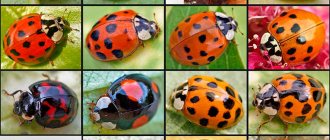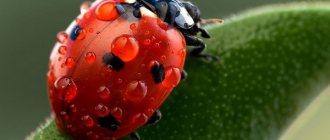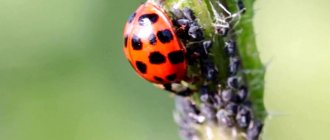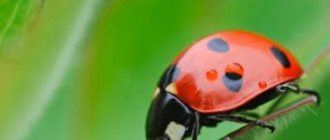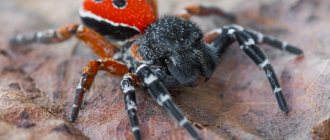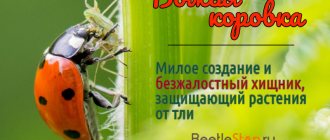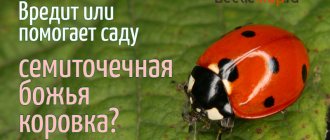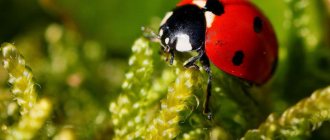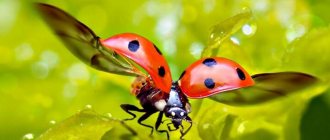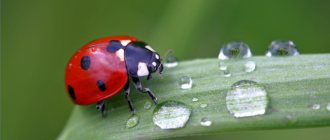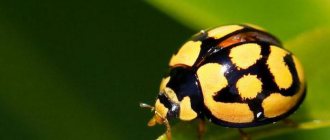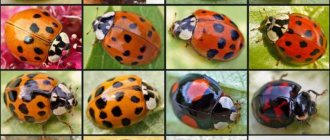Moscow is one of the greenest cities in the world. Parks, squares and natural areas occupy almost half of the capital's area. The number of trees and shrubs increases every year. Flowers add bright colors to the unique image of the city.
The condition of green spaces is monitored by specialists from the municipal services complex, among whom there are even entomologists. They identify pockets of pests that disrupt decorative plants, and beneficial insects that help preserve the diversity of urban flora.
Which of them benefit green spaces, and should people be afraid of them, said Elena Semenova, an entomologist at the Highways State Budgetary Institution.
Ladybug: Aphid Killer
Ladybugs are the most beneficial insects. They are valued not only in Moscow, but throughout the world. These seemingly harmless bugs are considered the main destroyers of harmful aphids.
“The ladybug cannot be confused with any other insect: the black dots on the red back immediately catch the eye. At the same time, few people know that there are quite a lot of their varieties. They come in white, black, yellow, and also with a different number of points: from two to 14. In total, there are about eight thousand species of ladybugs. In Moscow, the most common bugs are those with seven dots on a bright red shell,” says Elena Semenova.
Almost all representatives of this group of insects are predators. They eat not only aphids, but also scale insects, sawflies, psyllids and mites.
“There are different pests: leaf-biting, sucking, stem-boring. They are carriers of diseases that cause tree death. The main task of entomologists is to prevent this. Ladybugs and other predators help us with this, naturally reducing the number of harmful insects,” says Elena.
The larvae of ladybirds are particularly voracious. One individual eats from 70 to 300 aphids per day, helping to rid all types of urban plantings from them: from shrubs in courtyards to forested areas.
Adult beetles have quite powerful jaws. They can even bite a person, but this is not at all dangerous. There will be no damage to the skin, only a slight tingling sensation will be felt.
Lacewing: graceful predator
These are very elegant insects from the family Reticulate, one to two centimeters in size. The lacewing is easily recognized by its transparent wings. She got her name for her shiny golden eyes. The most common lacewings are pale green in color. Outwardly, they look a little like butterflies.
“Lacewings bring great benefits to trees and shrubs in public gardens and parks, protecting them from aphids, psyllids and caterpillars that curl and eat leaves. Moreover, only larvae hunt pests, while adult insects feed on pollen and nectar of plants. But even in the short time of its existence, the larva manages to bring invaluable benefits to the city, exterminating up to a thousand aphids per day,” says the entomologist.
At night, adult lacewings are guided by light, so they can often be seen on windows. Sometimes they fly into apartments and freeze on walls or lamps.
There is no need to be afraid of them: lacewings are completely harmless to humans. They may bite, but will not attack unless necessary. Moreover, this will only cause a slight unpleasant sensation, incomparable to a mosquito or wasp bite.
Dangerous caterpillars
There are poisonous caterpillars that harm not only crops, but also people. Many of them look very unusual and attractive. But it is better not to touch unfamiliar animals.
Poisonous caterpillars.
Hoverfly: almost like a wasp
The hoverfly is one of the most amazing insects found in Moscow. Due to its black and yellow color, it can easily be confused with a wasp, but if you look closely, you can see a lot of differences.
According to the entomologist, the hoverfly has only two wings, unlike the four-winged wasp, and does not have a poisonous sting. But hoverflies differ especially strongly from wasps in their behavior - these insects often hover in the air, defending their territory. At the same time, they produce a characteristic murmuring sound, due to which they got their name.
The hoverfly is also called the flower fly or the bee's helper because it helps pollinate plants by collecting nectar and pollen with its proboscis.
Not only adult flies benefit, but also their larvae. They live in the crowns of trees, feeding on insects harmful to plants.
Insects hibernate
Spring and summer pass - a celebration of life in central Russia. With the onset of autumn, all living things prepare for winter. Butterflies huddle in secluded places - tree hollows, under bark that has fallen off trunks, in the attics of houses. But not all butterflies overwinter this way. There are species that can overwinter in the egg stage or in the caterpillar stage, and some in the pupa stage. Those species of butterflies that overwinter in the egg stage try to hide their eggs in places where they would be more comfortable.
Most wintering caterpillars burrow into the forest floor or, like butterflies, climb into the bark that has fallen away from tree trunks, into rotten stumps and other places. Many butterfly caterpillars that overwinter in the pupal stage burrow into the ground and pupate there. And some pupate where their camouflage coloring is not noticeable.
Among representatives of the order Hymenoptera (wasps, bumblebees), fertilized females overwinter, huddled in the cracks of rotten stumps, under the trunks of fallen trees, which is where they can be found in winter.
The larvae of the golden bronze beetle overwinter in compost heaps. The rotting compost releases heat, and the larvae survive safely until spring. Rhinoceros beetle larvae spend the winter in rotting sawdust.
Very often during the winter thaw you can meet representatives of the order Diptera - snow mosquitoes. These creatures appear in winter, when there are no enemies - predatory and parasitic insects.
We know that with the onset of cold weather, birds, united in flocks, fly to countries with a warm climate. Butterflies also make such flights. For example, monarchs unite in flocks and fly for the winter from the northern states of the USA and Canada to Florida, Central America, Cuba, and the Bahamas. There they spend the winter on certain trees, which are now under protection. In the spring, the butterflies travel again, this time to the north, where they lay eggs and die. One can only wonder how the young monarchs find their way to the winter, because their parents, who flew from the south, died.
With the biology club, we went out into the forest and looked for wintering insects. We found everything: caterpillars, small leaf beetles, longhorned beetle larvae, and bedbugs. Sometimes small parasitic riders were found under the bark. They lay eggs on caterpillars. The larva emerges from the egg and feeds on the tissues of the caterpillar. First it eats the fat body, then the muscles and the circulatory system. The parasite, having completed its development, emerges from the skin remaining from the caterpillar and pupates on it, either on the surface of the earth or burrowing into the soil.
Fly
Representatives of the order Diptera - flies - also hibernate; they can often be seen between window frames. Two-spot ladybugs also overwinter. In our museum of A.S. Pushkin in the western Moscow region there are a lot of these bugs every year. During the thaw, the bugs wake up and how joyful it is to see them - the harbingers of spring. But it’s not easy for insects waking up in the winter thaw. They spend energy, but they have nothing to eat. So the prolonged winter thaw does not bode well for wintering insects.
Swimming beetle
Many insects and their larvae overwinter in water. For example, large beetles are fringed swimming beetles. As a child, skating on the first, still thin ice, I often saw these beetles swimming under the ice. I was surprised then how they breathed. Now I know that swimming beetles breathe in winter by collecting bubbles of oxygen released by aquatic plants. There is another way to obtain oxygen from water. Between the elytra and the abdomen of the swimming beetle there is a cavity, and this is where the beetle collects oxygen bubbles. But a beetle can breathe with the help of a bubble only at low temperatures, when all its processes are slowed down and a large amount of oxygen is not required.
Dragonfly larva
Dragonflies and representatives of the order Diptera, mosquitoes, overwinter in the larval stage. Dragonfly larvae have gills and breathe oxygen dissolved in water. The “bloodworms” known to fishermen—red worms—are the larvae of mosquitoes of the bell ringer family. Bells live in bottom mud. “Bloodworms” can be small or large—these are mosquito larvae of different species.
Another example of wintering of dipterans is observed in the raspberry stem gall midge. This creature overwinters in the larval stage. If you look closely at young raspberry shoots in winter, you can see swelling and growth of stem tissue. And by opening this incorrectly grown part of the stem, the so-called gall, you can see the orange larvae of the raspberry gall midge.
All hibernating insects have one goal during the wintering period - to survive in conditions of low temperatures. Before wintering, insects undergo various processes of body restructuring. One of the important processes is the accumulation of glycerol. All processes occurring during wintering require the presence of this substance.
In winter, the living tribe of insects disappears from our field of vision. Under the cover of snow, they are waiting for the hour of festive rebirth - the long-awaited spring.
A. L. Kalutsky, entomologist
Ktyr: robber fly
Another fly that benefits the city is ktyr. This predator has a rigid proboscis and poisonous glands, which allow it to quickly neutralize its prey.
“This is one of the most aggressive insects. Because of his lightning-fast reaction and gluttony, he was nicknamed the robber fly. Ktyr hunts almost all pests and is capable of biting through even very hard shells. It behaves very aggressively even towards such well-armed insects as wasps, bees or hornets,” says Elena Semenova.
Ktyr larvae are no less dangerous hunters. They are the ones who bring the greatest benefit to humans. The larvae live in the soil, feeding on pests that damage plant roots. These include wireworms, click beetles and caterpillars.
For a person, the bite of a bird is similar to a bee sting. It can be very painful and cause itching, burning and swelling. Therefore, it is advisable to avoid these insects, but under no circumstances should you kill them - they are very valuable and are even listed in the Red Book.
Inspection of green spaces
Entomologists of the State Budgetary Institution "Highways" conduct surveys of green areas from April to September, during the growing season of plants. Over the past summer season, they examined about 200 objects. These are areas along highways, highways, at MKAD interchanges, as well as public gardens and some large parks.
“If, as a result of monitoring, pest outbreaks are detected, we inform the specialists who care for the plants about the need to treat them with special preparations. In this case, safe biological agents are used that affect certain types of insects without endangering beneficial predators. If the number of pests is insignificant, then a mechanical method of control is used,” notes Elena Semenova.
According to the entomologist, due to the favorable environmental situation in Moscow there are quite a lot of beneficial insects. In addition, the city holds special events to increase their population. For example, in the winter the soil of flower beds is covered with wood chips, which allows insects to more comfortably survive the cold period.
And in some natural parks, special houses are installed for wintering insects. Outwardly, they resemble birdhouses, but without the front wall. The interior space of the houses is filled with dry hollow stems of nettle, horse sorrel, Sakhalin buckwheat, and tree branches and pine cones are placed. Osmium bees, pollinating plants of the entomophilous group, beneficial beetles and ladybugs usually live in such “hotels”.
Types of grasshoppers
These representatives of the insect kingdom, inhabiting almost all corners of the Earth, boast a rare variety of external and behavioral characteristics. There are about 7 thousand species of such creatures on the planet.
And each of them is endowed with its own characteristics. Types of grasshoppers primarily differ in size. Representatives of some varieties may have a length of one and a half centimeters, no more. But there are also giants, whose size reaches 15 cm.
By the way, female grasshoppers are noticeably larger than males and outwardly differ from them in the presence of an ovipositor - a special device of significant size designed for laying eggs. In size it can correspond to half the length of the female’s body, so it is simply impossible not to pay attention to it.
Also, the types of grasshoppers differ in their very varied colors. The coloring usually matches the environment where the insects live, acting as a kind of camouflage suit for the grasshopper. After all, it makes it invisible against the background of vegetation and landscape.
The color can be monochromatic, for example, green, but the color scheme varies significantly, surprising with the versatility of color tones. Also, the coloring of the species can be very impressive and bright, complemented by stripes and spots. All this diversity can be observed in the photo of grasshoppers .
Some types should be described in more detail.
1. The steppe grasshopper is one of the giants among the grasshoppers of Russia. And the size of such insects can reach up to 8 cm. Their wings are underdeveloped, they are either very short or completely absent. The color of these grasshoppers is green, sometimes with a yellowish tint and a longitudinal border of the same color.
They are distributed in different regions of southern Europe, in steppes covered with wormwood, and in ravines covered with sparse bushes. These insects are few in number, and the number of representatives of the species on Earth is constantly decreasing.
In the photo there is a steppe grasshopper
2. Green grasshopper . Adult specimens of this species have a body length of about 3 cm, but in some cases they can grow up to 6 cm. These creatures are found in some European countries, in the Asian territories of our country up to the Far East, as well as in Africa.
The jump length of such creatures can be up to 3 m. In addition, they are able to fly. These creatures chirp so loudly that they can be heard at a distance of 100 m. Males attract their partners with such concerts.
Green grasshopper
3. Greenhouse grasshopper is one of the smallest varieties. But its representative is capable of jumping almost half a meter in height. Outwardly, they no longer resemble grasshoppers, but spiders, but have huge antennae. The color of such creatures is brown or gray, decorated with dark spots.
For the most part, this is a resident of the central regions of China, but together with plants, such insects spread westward to Europe, right up to the Crimea, and on the other hand, moving east, they even reached the American continent. These grasshoppers prefer to live in greenhouses and conservatories, which is why they are called that.
Greenhouse grasshopper
4. Ball-headed grasshopper . This is a whole family of large grasshoppers, representatives of the long-whiskered suborder. The body sizes of such insects are large. Their head is large, spherical in shape, and the elytra are shortened. In various regions of the former USSR there are about 7 species of such grasshoppers. They are also found in Eurasia and northern Africa.
Ball-headed grasshopper
5. Giant weta - one of the largest and heaviest grasshoppers. The weight of such insects can reach up to 70 g and even rise higher. They are found in New Zealand, but not in the entire archipelago, but only on a very small island called Little Barrier, and are considered endemic. This creature can quite successfully defend itself from enemies with its huge (the length of the lower leg is 5 cm) and strong hind legs.
But such limbs do not help them jump; grasshoppers are apparently too heavy. But apart from the size, in appearance they are quite similar to their relatives from other species or crickets. Such insects can settle in caves, open spaces and forests of the mentioned island, as well as near populated areas.
Giant weta
6. Steppe fat man . The variety of such insects is considered extremely rare. Today, their range has decreased significantly. The existence of this species has been recorded in the Krasnodar Territory, in the vicinity of Rostov, in Kabardino-Balkaria, and in certain other regions of Russia. This is a black grasshopper , whose body has a bronze tint. There are indeed spotted individuals of this variety.
Steppe fat man
